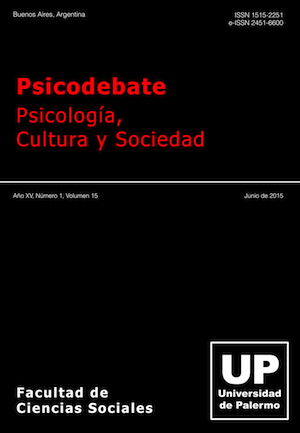Personal style of the therapist, attachment style and personality trait
Abstract
The aim of this study is to analyze the relationship between the personal style of the therapist, attachment style and personality trait. It was used the personal style of the therapist questionnaire (PST – Q), the Argentinean attachment inventory and the big five inventory. The study sample consisted of 120 psychotherapists average age of 36.28 years (SD = 9.65), and the average years of experience was 7.90 years (SD = 8.04). The analysis of the results showed that there is a positive, significant and low intensity between the personality factor of openness to experience and personal style of involvement, a negative correlation, significant and of medium intensity between low extraversion factor correlation and mode not anxious romantic attachment and a significant positive relationship between the low–intensity factor neuroticism personality and how anxious romantic attachment.
Downloads
References
Beutler, L., Machado, E. & Allstetter Neufeldt, S. (1994). Therapist Variables. En A. Bergin & S. Gardfield (Eds.), Handbook of Psychotherapy and Behavior Change (pp. 229–269). New York: Wiley.
Black, S., Hardy, G., Turpin, G. & Parry, G. (2005). Self–reported attachment style and therapeutic orientation of therapists and their relationship with reported general alliance quality and problem in therapy. Psychology and Psychotherapy: Theory, research and practice, 78, 363–377. http://dx.doi.org/10.1348/147608305X43784
Brennan, K., Clark, C., & Shaver, P. (1998). Self–report measurement of adult attachment: An integrative overview. En J. R. Simpson (Ed.), Attachment theory and close relationships (pp. 47–57). New York: Guilford Press.
Carreras, M., Brizzo, A., Gonzalez, R., Mele, S., & Casullo, M. M. (2008). Los estilos de apego en los vínculos románticos y no románticos. Estudio comparativo con adolescentes argentinos y españoles. Revista Iberoamericana de Diagnóstico y Evaluación Psicológica, 25(1), 107-124.
Castañeiras, C., Ledesma, R., García, F., & Fernández Álvarez, H. (2008). Evaluación del Estilo Personal del Terapeuta: Presentación de una versión abreviada del Cuestionario EPT–C. Terapia Psicológica, 26(1), 1–13.
Castro Solano, A. & Casullo, M. M. (2001). Rasgos de personalidad, bienestar psicológico y rendimiento académico en adolescentes argentinos. Interdisciplinaria, 18(1), 65-85.
Casullo, M. M. & Fernández Liporace, M. (2004). Evaluación de los estilos de apego en adultos. Anuario de investigaciones, 7, 183-192.
Corbella, S., Balmaña, N., Fernández Álvarez, H., Saúl, L., Botella, L., & García, F. (2009). Estilo personal del terapeuta y teoría de la mente. Revista Argentina de Clínica Psicológica, 28(2) 125-133.
Corbella, S., Botella, L., Saúl, L. A., García, F. & Fernández Álvarez, H. (2009, junio) Developing the therapist ́s personal style. Trabajo presentado en la 40th Annual Meeting of The Society for Psychotherapy Research, Santiago de Chile, Chile.
Corbella, S., Fernández Álvarez, H., Saúl Gutierrez, L., García, F., Botella, L. & García del Cid, L. B (2008) Estilo personal del terapeuta y dirección de intereses. Aportes del Psicología 26(2), 281–289.
Costa, P. & McCrae, R. (1992). Revised NEO personality Inventory (NEO PI R) and NEO five factor inventory (NEO FFI) professional Manual. Odessa: Psychological Assessment Resources.
Estada Arana, B. (2014) Correlaciones entre el estilo personal del terapeuta y escalas clínicas del MMPI II. Revista Argentina de Clínica Psicológica, 23(2), 153–162.
Fernández-Álvarez, H. & García, F. (1998). El estilo personal del terapeuta: Inventario para su evaluación. En S. Gril, A. Ibáñez, I. Mosca & P. L. R. Sousa (Eds.), Investigación en Psicoterapia (pp. 76-84). Pelotas: Educat.
Fernández Álvarez, H., García, F., Lo Bianco, J. & Corbella, S. (2003). Assessment Questionnaire on the Personal Style of the Therapist PST–Q. Clinical Psychology and Psychotherapy, 10, 116–125. http://dx.doi.org/10.1002/cpp.358
García, F., & Fernández Álvarez, H. (2007). Investigación empírica sobre el estilo personal del terapeuta: una actualización. Revista Argentina de Clínica Psicológica, 16(2), 121–128.
Henry, W., Schacht, T. & Strupp, H. (1990). Patient and therapist introject, interpersonal process and differential psychothterapy outcomes. Journal of consulting and clinical psychology, 58, 768–774. http://dx.doi.org/10.1037/0022-006X.58.6.768
Hernández Sampieri, R., Fernández Collado, C. & Baptista Lucio, P. (1991). Metodología de la Investigación. México: McGraw.
Huppert, J. D., Bufka, L. F., Barlow, D. H., Gorman, J. M.,Shear, M. K. & Woods, S. W. (2001). Therapists, therapistsvariables and cognitive behavioral therapy outcome in a multicenter for panic disorder. Journal of Consultingand Clinical Psychology, 69, 747–755. http://dx.doi.org/10.1037/0022-006X.69.5.747
International Test Commission. (2014). ITC. Retrieved from ITC: http://www. intestcom.org/_guidelines/guidelines/users/quality.html
John, O. P., Donahue, E. M., & Kentle, R. L. (1991). The Big Five Inventory— Versions 4a and 54. Berkeley, CA: University of California, Berkeley, Institute of Personality and Social Research.
Luborsky, L., McLellan, A. T., Woody, G. E., O’Brien, C. P., & Auerbach, A. (1985). Therapist success and its determinants. Archives of General Psychiatry, 42, 602–611. http://dx.doi.org/10.1001/archpsyc.1985.01790290084010
Noftle, E. & Shaver, P. (2006). Attachment dimensions and the big five personality traits: Associations comparative ability to predict relationship quality. Journal of research in personality, 40, 179–208. http://dx.doi.org/10.1016/j.jrp.2004.11.003
Rial, V., García, F., Castañeiras, C., Gómez, B. & Fernández Álvarez, H. (2006). Estilo personal del terapeuta que trabajan con pacientes severamente perturbados: un estudio cuanti y cualitativo. Revista de la asociación española de neuropsiquiatría, 2(98), 191–208.
Rubino, G., Barker, C., Roth, T. & Fearon, P. (2000). Therapist empathy and depth of interaction in response to potencial alliance rupture. Psychotherapy research, 10, 408–420. http://dx.doi.org/10.1093/ptr/10.4.408
Shaver, P. R. & Brennan, K. A. (1992) Attachment style and the big five personality traits: their connection wirh romantic relationship outcomes. Personality and Social Psychology bulletin, 18, 532–545. http://dx.doi.org/10.1177/0146167292185003
Skourteli, M. & Lennie, C. (2011). The therapeutic relationship from an attachment theory perspective. Counselling psychology review, 26(1), 20–33.
Authors who publish with this journal agree to grant Psicodebate copyright and right of publication and accept the work being licensed under a Creative Commons Attribution License that allows others to share the work with an acknowledgement of the authors and Psicodebate.

















